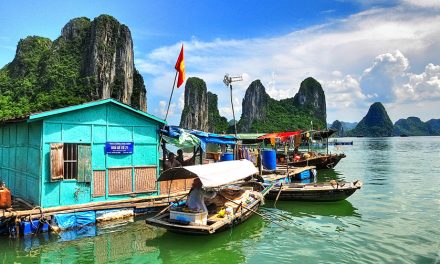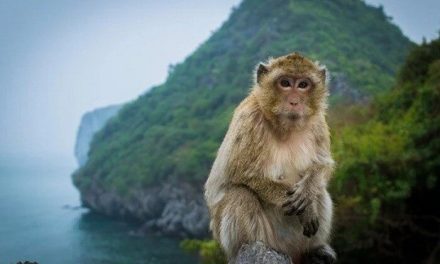Explore Cat Ba Langur: Amazing Halong Bay wildlife and ecosystem
It is also a sanctuary for the critically endangered Cat Ba Langur, one of the world’s rarest primates, now on the brink of extinction.
Now, join Bhaya to dive into the unique traits of this endemic species.
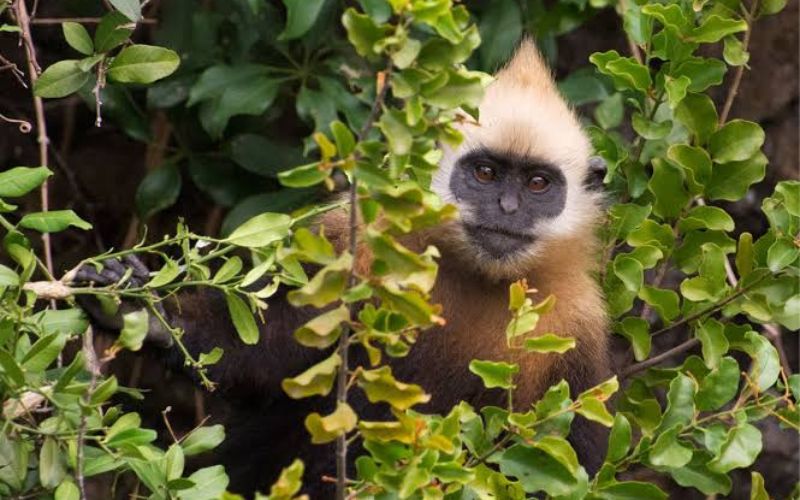
Cat Ba Langur: A unique primate species
In terms of physical characteristics, the Cat Ba Langur has a body length of 43 to 57 cm, especially distinguished by its long tail which not only enhances its unique appearance but also serves an essential function in maintaining balance while moving.
Typically, this species gives birth to only one offspring at a time after approximately six months of pregnancy.
Newborn langurs are born with bright orange fur and gradually darkens to black when they mature. Besides, humans often distinguish between male and female langurs by observing their fur coloration.
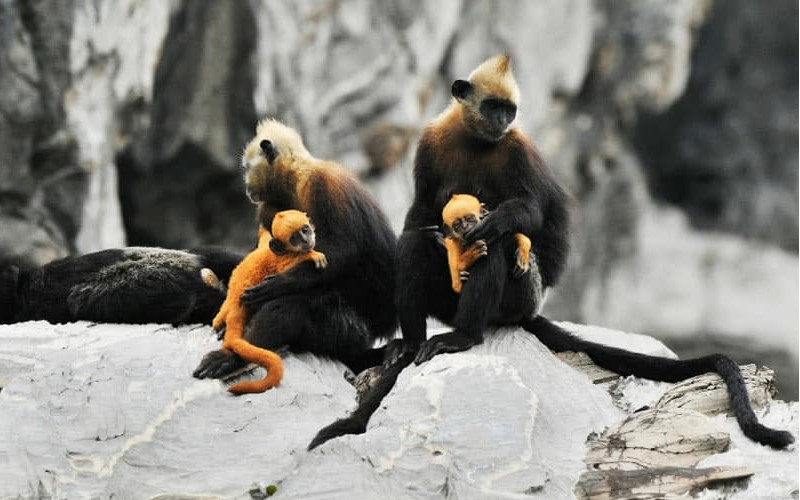
Particularly, the fur on the head and shoulders of males is often pale white, sometimes with a hint of light yellow, while females have darker fur, which stands out strikingly against their jet-black coats.
The Cat Ba langur usually feeds on leaves and fruits. During the day, they typically move together to limestone areas in search of food. At night, in contrast, they go back to the cave to rest and sleep.
Habitat and ecosystem of the Cat Ba Langur
In addition, The Cat Ba langur lives in groups similar to family units, with one male langur leading the group in foraging, warning of potential threats to the family, and finding sleeping spots.
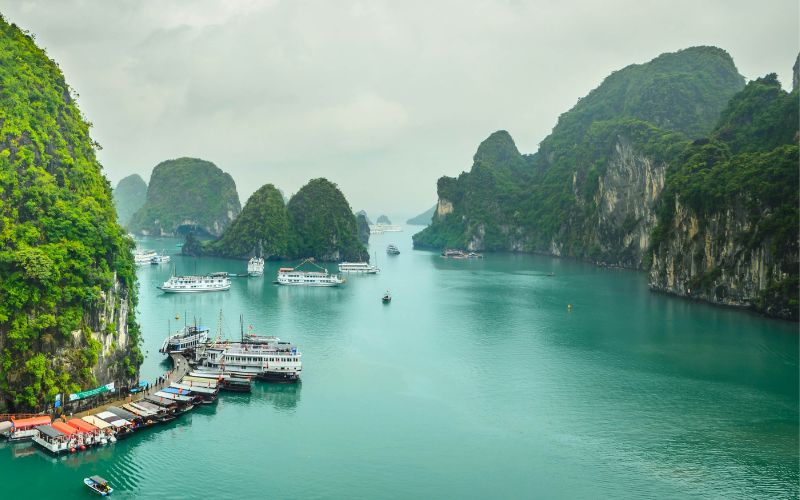
Especially, Cat Ba Island possesses a unique limestone forest ecosystem, which creates an environment that is both rare and essential for the survival of the Cat Ba langur. That is also the primary reason why visitors typically only see the Cat Ba langur in this area.
This species is a symbol of the island’s unique biodiversity and has become a focus of conservation efforts due to its endangered status and the critical need to preserve its habitat.
Threats to the Cat Ba Langur and conservation efforts
By the 1970s and 1980s, the population had sharply declined to only 500 – 600 individuals. By 2016, the total population was estimated to be around 50 individuals. Thanks to conservation efforts, the Cat Ba Langur population has grown to around 85 individuals, counted in 2024. However, the species remains at risk of extinction and still faces serious challenges to its survival.
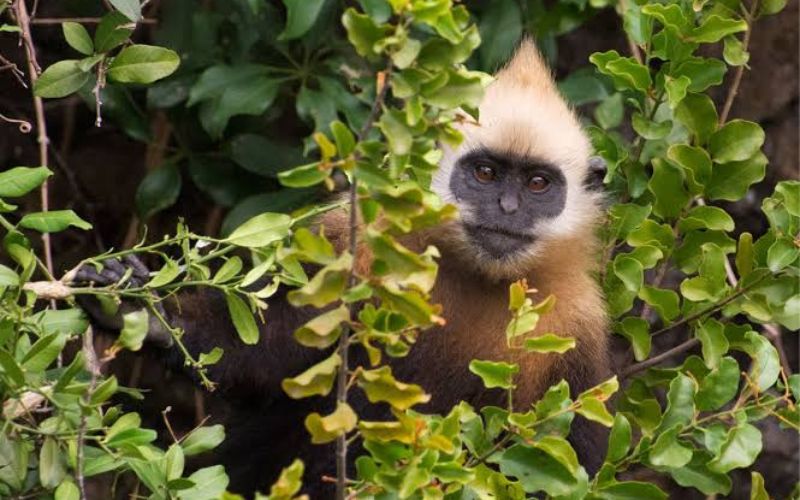
The primary reasons often stem from the exploitation of limestone forests, leading to habitat loss and food resources of this species. In addition, poaching for meat, medicine, and commercial purposes has further contributed to their endangered status.
Regarding conservation efforts, the “Cat Ba Langur Conservation Project” was established in 2000 with the aim of protecting and promoting the development of this rare primate species.
In addition, the project collaborates closely with local authorities in Cat Ba, continuously working to raise awareness and educate the community on how to protect this endangered species, with the goal of fostering public involvement in conservation efforts.
Currently, Cat Ba National Park is collaborating with various international conservation organizations, focusing on three main missions to preserve and develop the Cat Ba Langur:
- Stabilizing the langur population by raising awareness and preventing hunting activities.
- Establishing strictly protected areas to ensure suitable habitats for the langur population.
- Enhancing reproductive success, contributing to the recovery of the species in the wild.
How to see Cat Ba Langurs in Halong Bay
This is one of the largest protected forests in Vietnam and a UNESCO World Biosphere Reserve, which conserves a rich variety of ecosystems along with numerous rare species.
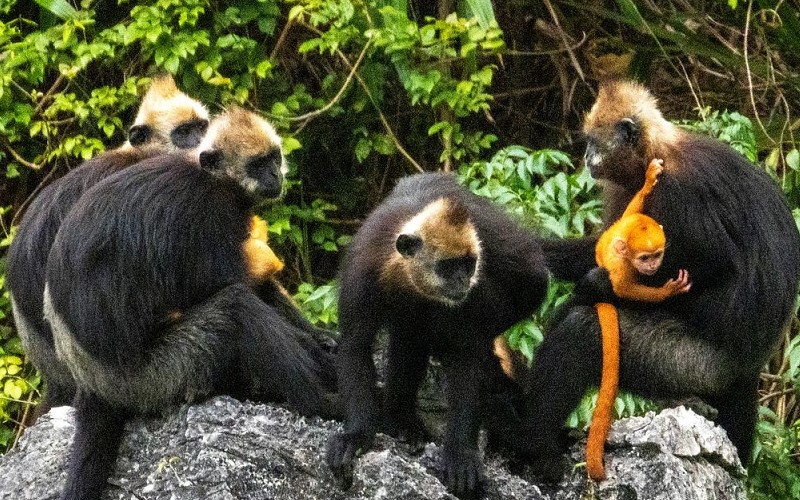
To visit Cat Ba Island, travelers can consider the following transportation options:
- Speedboat: Multiple departures are available daily, offering various schedules, ticket prices, and service quality for passengers to choose from. Typically, there are 2-5 trips per day between 7:00 AM and 3:00 PM, with a travel time of 40-60 minutes.
- Cable Car: The Cat Hai-Phu Long cable car station is located about 3 kilometers from Got Ferry Terminal. Each ride on the cable car takes approximately 10 minutes, providing a fast and scenic route to the island.
- Ferry from Tuan Chau Port: This option includes five daily ferries departing from Tuan Chau Port to Cat Ba Island, starting at 7:30 AM. Each trip takes around 45-50 minutes.
- Bus: From Hai Phong City, take bus 16C to Dong Bai Ferry Terminal. After crossing the ferry, transfer to bus number 14 at Cai Vieng to reach Cat Ba Island’s town center.
Note: To save costs when traveling to Cat Ba independently, it is advisable to avoid traveling during holidays and weekends, as service prices tend to increase significantly during these times. If you visit on a weekend, it’s recommended to take the cable car, as the ferry terminal is often overcrowded, leading to long waiting times
How to support the conservation efforts for Cat Ba Langur
Support the Cat Ba Langur Conservation Project

Learn more about the project at
https://www.facebook.com/catbalangur/photos
The Cat Ba Langur Conservation Project, funded by Muenster Zoo and the Zoological Society for the Conservation of Species and Populations (ZGAP) from Germany, operated in Cat Ba National Park through Vietnam’s Ministry of Agriculture and Rural Development from 2000 to 2018. From 2019 to 2023, Zoo Leipzig GmbH, a German NGO, continued the project with funding of over $610,000. The project focuses on:
- Habitat restoration: Reforestation and connecting fragmented forests to provide safer habitats.
- Wildlife monitoring: Conducting regular checks to understand the langurs’ numbers and activities.
- Community involvement: Educating local communities about the alarming status of the Cat Ba Langur and its critical role in the Halong Bay ecosystem.
You can support this initiative through donations or volunteering for awareness campaigns.
Supporting Give and Grow Organization
Give and Grow is a nonprofit organization focused on conservation and community development projects worldwide, and now they are working on restoring the biodiversity of the Cat Ba Archipelago, with a particular emphasis on the Cat Ba Langur.
One of Give and Grow’s significant achievements is its successful collaboration with local anti-poaching units, which has helped facilitate a 170% increase in the Cat Ba Langur population, growing from just 40 individuals at their lowest point to around 70 individuals.
You can support Give and Grow’s efforts through donations, volunteering, or spreading awareness about its initiatives through social media platforms.
Promote local programs that aim to protect the species
One of them is the local project from Cat Ba National Park and local authorities. Particularly, they implemented projects called “Langur Guardians” and “Forest Protection Clubs” in order to prevent hunting of the Cat Ba Langur, along with increased patrols.
These efforts reduced illegal hunting, and many former hunters switched to fishing or tourism. Some even joined the forest protection initiatives. Additionally, the park raised awareness and promoted replanting of native trees, aiding the langur population’s recovery.
Conclusion
This destination is perfect for those seeking to explore the wonders of nature and immerse themselves in the pristine beauty of Halong Bay.

